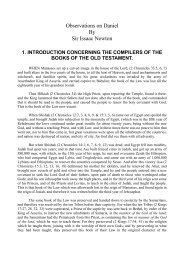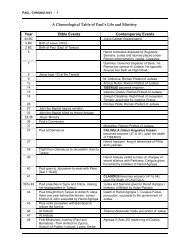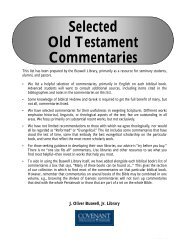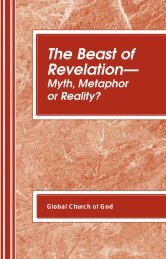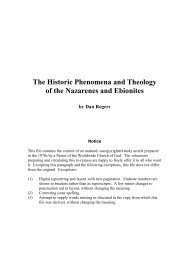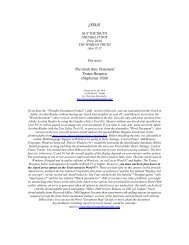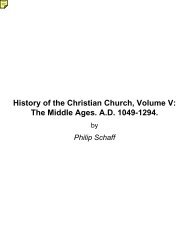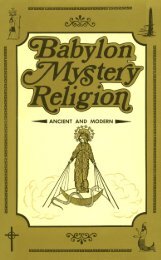by Percy E. Corbett - friendsofsabbath.org
by Percy E. Corbett - friendsofsabbath.org
by Percy E. Corbett - friendsofsabbath.org
Create successful ePaper yourself
Turn your PDF publications into a flip-book with our unique Google optimized e-Paper software.
13<br />
"The first ground of God, the first ground of the saints in Britain, the rise and foundation of all<br />
religion in Britain, and the burial place of the Saints."<br />
William of Malmesbury also wrote concerning the original church at Glastonbury:-<br />
"Of wattle work at first, it savoured somewhat of heavenly sanctity even from its very<br />
foundation and exhaled it all over the country, claiming superior reverence." A model of the<br />
wattle church exists in the British Museum.<br />
How does one account for the fact that 'Jerusalem' which was written <strong>by</strong> a British mystic,<br />
William Blake, and is often described as our second National Anthem, contains the following<br />
words:-<br />
And did those feet in ancient time<br />
Walk upon England's mountain green ?<br />
And was the Holy Lamb of God<br />
On England's pleasant pastures seen ?<br />
And did the countenance Divine<br />
Shine forth upon our clouded hills ?<br />
And was Jerusalem builded here<br />
Among those dark satanic mills ?<br />
William of Malmesbury was invited <strong>by</strong> the Abbot of Glastonbury to study the ancient MSS<br />
there. Referring to the Eleutherian Mission at Glastonbury, A.D. 183, he wrote:-<br />
"They also found the whole story in ancient writings how the holy apostles, having been<br />
scattered throughout the world, St. Philip the Apostle coming to France with a host of disciples,<br />
sent twelve of them into Britain to preach, and that - taught <strong>by</strong> revelation - constructed the said<br />
chapel which the Son of God afterwards dedicated to the honour of His Mother. Their leader, it<br />
is said, was Philip's dearest friend, Joseph of Arimathea, who buried our Lord."<br />
Jowett states that Joseph died on the 27th July, A.D. 82, that he was buried at Glastonbury,<br />
and that the lid of the sarcophagus which contained his body bore the following inscription<br />
under his initials:-<br />
"Ad Brittanos veni post Christum Sepelevi, Docui, Quievi." (To the Britons I came after I buried<br />
the Christ, I taught, I have entered my rest.)<br />
Cressy, in "Church History of Brittany" writes:-<br />
"Joseph was buried near the little wattle church he built."<br />
Maelgwyn of Avalon, circa A.D. 450, wrote:-<br />
"Joseph of Arimathea, the noble Decurion received his everlasting rest with his eleven<br />
associates in the Isle of Avalon. He lies in the bifurcated line of the Oratorium of the Adorable<br />
Virgin."



